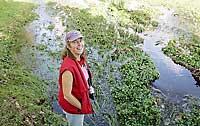Activist's fight for stream with no name earns her title

Tonight, for her efforts to restore Stream 0056, the Adopt-A-Stream Foundation will name her the Seattle area's "Streamkeeper of the Year."
Mooney is a bit like a salmon swimming upstream. She never stops moving, and her task seems so long and exhausting that one wonders how she keeps going.
Mooney and her family moved to Kenmore in 1995. In front of their house on 60th Avenue Northeast, Stream 0056 runs in a roadside ditch. Only a few cutthroat trout now live in the stream, which once was home to coho salmon.
In 1998, Mooney noticed a ditch in the side of a wooded knoll down the street from her house. A developer was draining a boggy area that had fed a tiny tributary of Stream 0056.
Mooney wanted to do something, but didn't know where to start.
"I was casting around in all these different directions," she said. "I tried talking to the city; I tried talking to the Army Corps of Engineers."
Mooney also started talking to her neighbors and to fisheries biologists, wetlands specialists and drainage experts.
A number for a name
She even found out that Native Americans in the Kenmore area had once had a proper name for Stream 0056: "Tchet-Cha-Thl," or Little Creek. Small creeks all over the state were assigned numbers by the old Washington Department of Fisheries.
Eventually, in 2001, Mooney formed the nonprofit People for an Environmentally Responsible Kenmore (PERK) and filed suit against Lake Forest Park Associates, a development company that owns the property on 60th Avenue Northeast.
The larger issue that Mooney got involved in — protecting environmentally sensitive areas from development — is a common one in suburban communities all over the Seattle area.
"There's a lot of work by citizens and government that goes into creating good land-use code," said Claudia Newman, an environmental attorney who represented PERK in the group's legal action.
"But," Newman said, "when it comes to enforcing the law one development at a time, they don't get enforced very well — when obviously the citizens through the comprehensive plans and the land-use codes have said that protecting the environment is a high priority."
Ecologically, wetlands and open spaces are important to the health of streams for many reasons. In addition to serving as natural filters, these areas slow runoff and store water during dry spells, helping to regulate the flow of water in streams.
"On rainy days, you can really tell the difference in health" between relatively pristine streams and those with lots of asphalt and concrete upstream, said Brian Bodenbach, a local landscape designer who has worked on watershed management projects for 20 years.
Stream 0056 still has a long way to go. As it spills out of a culvert under Bothell Way, the water runs beige and smells vaguely of oil. Weirs at the stream's mouth and at Bothell Way serve as fish barriers between Lake Washington and the creek.
Wider involvement
Mooney's task is to restore some of the ecological function of the creek's watershed. In a suburban area, that means getting the participation of hundreds of homeowners in a watershed.
So, as PERK's suit progressed, Mooney came to realize that while fighting the good fight in the courtroom might win her one victory on one plot of land, what she really needed was to make stream stewardship an issue for the whole town.
The network she'd built for the lawsuit turned out to be a great asset. "All of these people that I had contacted for the contentious issue were the same contacts that I could go to, to be stewards of the stream."
With a $1,900 grant from the King County Water Quality Education Fund, Mooney started a restoration project with students at her daughter's school, Lockwood Elementary. The students surveyed insects and fish in the river, planted vegetation on the stream banks and spoke at city council meetings. Stream 0056 was finally getting some attention.
"People aren't attracted by lawsuits," she said. "That's why having the kids in the stream is so great."
Mooney also found some mentors next door in Lake Forest Park, where people like Mamie Bolender and Carol Dahl, two of the founders of the Lake Forest Park Stewardship Foundation, have been working to organize the community around local watershed issues for 15 years.
"Our municipalities have to work together — that's what we're really pushing," said Bolender.
Moving ahead
Last spring, PERK's suit was settled. Lake Forest Park Associates agreed to postpone development of the 60th Avenue Northeast property while Mooney and others looked for a way to reserve the land for conservation purposes.
Dahl, Bolender and Mooney, with help from Kenmore and Lake Forest Park city staff members, applied for a King County Conservation Futures Grant. In July, the county recommended that $200,000 be given to Kenmore and $50,000 to Lake Forest Park for the purchase of some of the forested wetlands along 60th Avenue Northeast that feed Stream 0056.
"It was a very creative solution, having the city get involved and getting the grant money," said Newman.
Tom Murdoch founded the Adopt-A-Stream Foundation in Everett in 1985 to teach people how to become stewards of their watersheds. Elizabeth Mooney completed one of the foundation's Streamkeeper Field Trainings in 2002.
"She's gotten the community mobilized to turn things around in that creek," Murdoch said. "She's a wonderful example of a watershed leader. She's gotten people thinking that what seemed to be impossible is now possible — and that's getting a salmon run back in that stream."
Jim Downing: 206-515-5627 or jdowning@seattletimes.com